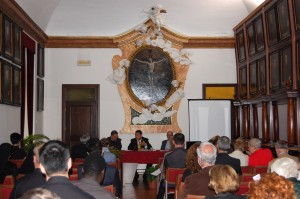 The oratory of the generalate house of the Camillians, which is beautiful, refined, and full of portraits and works of art, opened its doors yesterday to the conference ‘St. Camillus de Lellis and his Friends’ in order to talk, first and foremost, about the saint of the sick in the fourth centenary of his death (14 July 1614), but also to discuss his epoch and the flourishing of religious Orders which, between the Renaissance and the Baroque, gave a new spirituality to the Eternal City which in its turn was translated into churches and artistic masterpieces. The animator and organiser of the conference was Lydia Salviucci Insolera, a lecturer at the Pontifical Gregorian University, who explained this initiative in the following terms: ‘The next year is a jubilee year for the Camillians and I liked the idea of celebrating this saint and at the same time the efforts that the Camilllians have engaged in to conserve their artistic heritage in the best way possible. Theirs is an example to be followed. Lastly, it is an opportunity to investigate the movement of ideas within the various religious Orders between spirituality and art during the great ferment of Rome of that epoch’.
The oratory of the generalate house of the Camillians, which is beautiful, refined, and full of portraits and works of art, opened its doors yesterday to the conference ‘St. Camillus de Lellis and his Friends’ in order to talk, first and foremost, about the saint of the sick in the fourth centenary of his death (14 July 1614), but also to discuss his epoch and the flourishing of religious Orders which, between the Renaissance and the Baroque, gave a new spirituality to the Eternal City which in its turn was translated into churches and artistic masterpieces. The animator and organiser of the conference was Lydia Salviucci Insolera, a lecturer at the Pontifical Gregorian University, who explained this initiative in the following terms: ‘The next year is a jubilee year for the Camillians and I liked the idea of celebrating this saint and at the same time the efforts that the Camilllians have engaged in to conserve their artistic heritage in the best way possible. Theirs is an example to be followed. Lastly, it is an opportunity to investigate the movement of ideas within the various religious Orders between spirituality and art during the great ferment of Rome of that epoch’.
The programme of the conference was a very full one. Acting as the host of the generalate house, the Superior General of the Camillians, Father Renato Salvatore, spoke about St. 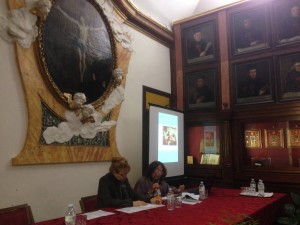 Camillus, an unknown St. Camillus, who in his youth was a great gambler, the cross of the mother who gave birth to him, a new St. Elizabeth, at the age of almost sixty, who then converted and became a Capuchin. Father Salvatore then related how the saint of the sick was himself nearly always ill. And to the point of being expelled from the Order of the Capuchins. At the beginning, Father Salvatore explained, the idea of Camillus was to create group of laymen who would care for the sick without payment, generously, and in a spirit of charity. Only later did he found the new Order of the Ministers of the Sick whose Rules were approved by Pope Sixtus on 18 march 1586. He cared for others without payment but his wound in his foot never healed. ‘St. Camillus died, tormented by pain on his upper foot and because of a strong inability to take food which lasted for a whole month. And he died in the room next to this one’, Father Salvatore explained, ‘which was an infirmary and which is now a chapel’.
Camillus, an unknown St. Camillus, who in his youth was a great gambler, the cross of the mother who gave birth to him, a new St. Elizabeth, at the age of almost sixty, who then converted and became a Capuchin. Father Salvatore then related how the saint of the sick was himself nearly always ill. And to the point of being expelled from the Order of the Capuchins. At the beginning, Father Salvatore explained, the idea of Camillus was to create group of laymen who would care for the sick without payment, generously, and in a spirit of charity. Only later did he found the new Order of the Ministers of the Sick whose Rules were approved by Pope Sixtus on 18 march 1586. He cared for others without payment but his wound in his foot never healed. ‘St. Camillus died, tormented by pain on his upper foot and because of a strong inability to take food which lasted for a whole month. And he died in the room next to this one’, Father Salvatore explained, ‘which was an infirmary and which is now a chapel’.
It was then the turn of Felice Accrocca, of the Pontifical Gregorian University, to speak about the Capuchin spirituality which greatly inspired the saint of Abruzzo: ‘As the Father General of the Camillians’, he concluded, ‘he remained in his Rules a Capuchin’.
Father Giovanni Grosso talked about the Carmelite churches in Rome: San Martino ai Monti and the Transpontina. These are churches which St. Camillus certainly saw during his walks in the city of Rome looking for sick people to help.
Lydia Salviucci Insolera then talked about the Rome of St. Camillus seen through the eyes of Ignatius di Loyola, with a list of the many relationships that existed between this Spanish saint and the Roman religious Orders: St. Camillus and St. Ignatius, however, never met because Camillus, when Ignatius died, was only six and still lived in the house where he was born in Bucchianico with his parents. However, when he reached Rome Camillus studied at the Roman College, met St. Bellarmino and, when dying in the infirmary of the generalate house, asked to read only two books: a theological text by Bellarmino and a short book by another Jesuit, Luca Pinelli. In the eternal symbol of the cross – a red cross and a 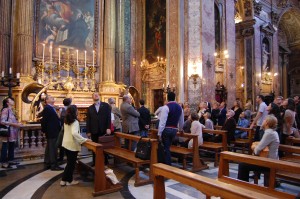 shortened cross which St. Camillus greatly wanted, not least to be distinguished (these were his words) from the Jesuits – the two saints encountered each other. ‘For the Jesuits to meditate upon the Cross’, Prof. Salviucci Insolera explained, ‘was like engaging in the third week of spiritual exercises’: a truth related with pictures in the Chapel of the Passion of the Church of Jesus in Rome. The Camillians wore a living red cross on their cassocks in a perpetual meditation. And so powerful was that symbol, on battle fields as well, that it lasted down the centuries and still exists today, being transformed into an institution: the Red Cross. For the Jesuits, this symbol, powerful in its beauty and translated into works of art, was very important. Such was not the case with the Camillians who used it to set a good example and to narrate with simplicity the works of their Founder, as was emphasised by Prof. Emilia Talamo of the University of Calabria.
shortened cross which St. Camillus greatly wanted, not least to be distinguished (these were his words) from the Jesuits – the two saints encountered each other. ‘For the Jesuits to meditate upon the Cross’, Prof. Salviucci Insolera explained, ‘was like engaging in the third week of spiritual exercises’: a truth related with pictures in the Chapel of the Passion of the Church of Jesus in Rome. The Camillians wore a living red cross on their cassocks in a perpetual meditation. And so powerful was that symbol, on battle fields as well, that it lasted down the centuries and still exists today, being transformed into an institution: the Red Cross. For the Jesuits, this symbol, powerful in its beauty and translated into works of art, was very important. Such was not the case with the Camillians who used it to set a good example and to narrate with simplicity the works of their Founder, as was emphasised by Prof. Emilia Talamo of the University of Calabria.
There were many other papers which talked about a Rome of vitality, a Rome rich in spirituality, fecund in works of art, a Rome where new religious Orders were born to bring Masses to the Church and where the bases of modernity were lain. The occasion was also rich because of the opportunity it provided to admire the valuable museum of the Camillians (The St. Camillus de Lellis Museum: editor’s note) and the splendid Church of St. Mary Magdalene.
The press on the activities of the fourth centenary



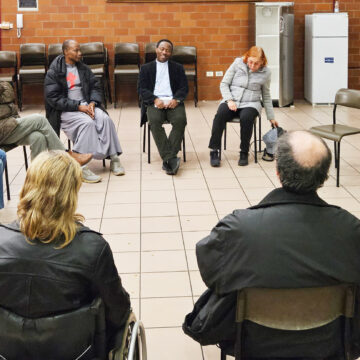




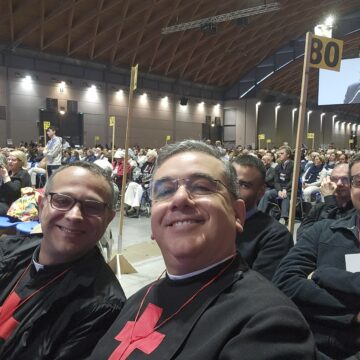






Camillians on Facebook
Camillians on Twitter
Camillians on Instagram